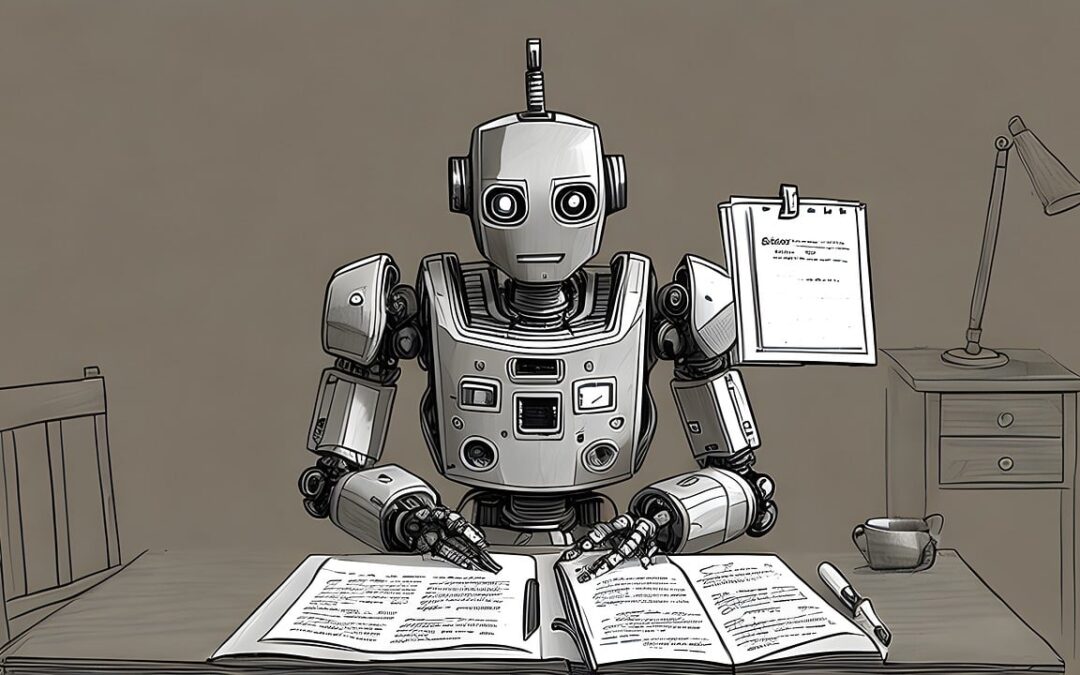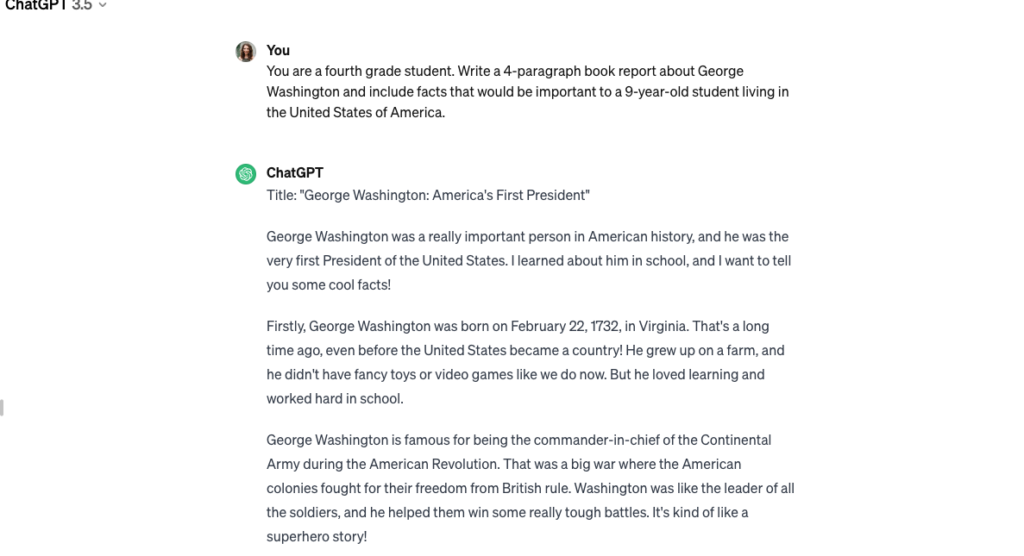
CHOCOLATE-FUELLED THOUGHTS

What The Average Human Should Know About AI
It’s been a year since ChatGPT splashed onto the national discussion. AI isn’t anything new, but the ability to interact with a chatbot and have it do your bidding in seconds IS new. Most people played with a little over Christmas break, a bunch of university students learned new ways to procrastinate, and most people moved on with their lives. Every week, there’s a new post about either the dangers of AI or the Amazing! New! Thing! It Can Do!
My AI Crash Course
Unfortunately, in my industry of content marketing, we couldn’t shut our eyes tight and pretend ChatGPT hadn’t changed everything. As an editor, I started my AI spiral by learning how to detect it in our freelance community. And the tl/dr of that journey is: We can only identify writing that sounds like AI. We can never be sure.
But if there was an AI detection software, I dabbled in it. Eventually, we did enough testing to develop our in-house standard for what makes content “AI-adjacent.” If writing looks like AI and smells like AI, we send it back to a freelancer to make it sound more human. We’ve developed several guides and tutorials to help writers and editors imbue life back into their writing. And here’s what I’ll say to the content creators out there: AI is pretty good. But it can only regurgitate ideas that already exist. The magic is in the innovation and the humanity you bring to your craft. Your work is still worthy. (Sidenote: You should pay attention to this lawsuit for how AI might impact your copyright protections.)
I was also asked to help edit AI-assisted content. This spiraled into research and development of an AI-assisted product for our company to market. This fully launched product now means that I build a GPT for a specific client and then use that to craft content, including web pages, blogs, social media, white pages, or ebooks. Then, at least two of our editorial staff give it a good massage to add in the human element. We fact-check, add links, and rephrase things that sound distinctly “robotic.”
I do a lot of reading and researching on AI, staying up to date by reading little-known substacks on LLMs and machine learning, googling words and concepts I don’t understand until I know just enough to be dangerous.
I tell you all of this to establish the parameters of my “credentials.” I understand the impact of AI as it relates to me and to my industry. I’m not an ethicist, and I’m not a computer science nerd. (Not throwing shade; I happen to be married to one of those. He’s the best.) I’ve thought about AI as an editor, as a writer, as a former teacher, as an employee who wants to keep her job, and as a parent raising kids who are trying to hold onto their integrity in a world that makes it easier to cheat than to do the right thing. I don’t pretend to have answers or to grasp the scope of this new advancement fully, but the following are ways of framing the big ideas so I can sleep at night.
Things Every Person Should Know About AI
If we were sitting at a dinner table and you asked me, this is the cliff’s notes version of what I think everybody needs to understand about this new technology.
- AI won’t take everybody’s jobs. But it will change them. Remember when the iPhone came out? It was just a nifty toy at first. Now, we literally can’t function without them. AI is still in its “nifty toy” stage. But change, it is a’comin’. Don’t be scared. You’re still integral to the process. But you’ll need to adapt quickly. Pay attention to your industry and how AI gets integrated. Jobs may go away, but there will be new types of jobs to manage the non-human replacements. Be ready to pivot.
- AI is only as scary as the people who get to use it. Just like our iPhones are both the most useful and dangerous tools, AI comes with good and bad. The laws and ethics are already up for debate in the highest global echelon, but if history has taught us anything, it’s that the bad guys don’t really care about laws designed to stop them from doing bad guy things. This is just another potential weapon in their arsenal. Combat the bad guys by learning how to use AI for good stuff.
- AI is not a replacement for our humanness. In his presentation about AI in 2023, tech consultant Ben Evans talks about the difference between artificial intelligence and general intelligence. Before 2023, most of our machines could only do the thing they were built to do. My “intelligent dishwasher” will still only run the wash and rinse cycle, even if I fill it with clothes and use laundry detergent instead of Cascade. It isn’t “intelligent” enough to adapt to a totally new situation. In contrast, a dog or an octopus, when given a new toy, will find a way to interact with it that might be totally different from something it’s done before. That’s “general intelligence.”
The thing is, there’s something that makes humans even more different. We aren’t sure exactly how to quantify human intelligence (although I’ve seen lots of attempts that involve math that are impressive but still lacking), but the general agreement is that humans have an X factor that we don’t know how to replicate in a machine. Or, at least, we don’t know how to measure if we’ve replicated it.
I’ll tell you my theory: Our X factor is our soul.¹ We have an internal moral compass, whether we choose to use it or not. A dog can’t tell you whether it’s right to tear up the couch cushions; he just knows he can. A human has the ability to assess the situation and make a moral choice. As far as we know, AI can recognize patterns, analyze data, and even recommend a “best” choice, but it lacks a soul and a moral code (other than what it’s been trained on) to make decisions for itself. It can advise, but it cannot (or should not) decide. That’s on you.
How To Use AI In Real Life
It’s not enough to just read the news and wring our hands. Here are my tips for daily life in a world where AI exists:
Do not trust. Always verify.
Learning how to use AI to make your life easier is a worthwhile investment of time. But since you’re the one with a soul, you can’t just blindly trust it. The robots hallucinate, yo. They make stuff up. And they make it sound like it’s totally true. When asked to discuss news articles about the cancer-causing agents in orange juice, AI fabricated an entire New York Times article about a non-existent study.² We can’t blindly believe everything we read on the internet, and we can’t blindly trust that AI can do it better than us. No matter how you get your internet, you should be a savvy BS-detector when it comes to ads, spam, linkbait, hallucinations, and marketing ploys. Learn to fact-check. Learn what a reliable source is. Build your critical thinking muscles. And be thorough enough that you don’t miss when a chatbot tries to get away with lies, damn lies, and hallucinations.
Learn how to talk to the robots.
The quality of the question you ask will determine the quality of the answer. In the example above about the false New York Times article, part of the problem was how the question was phrased to the AI. Because the prompter asked for articles about how orange juice causes cancer, in the absence of any known facts, the robot assumed it was true and crafted the requested article in the style of the New York Times. A better prompt would be, “Identify sources about the impact of orange juice on health.” There are plenty of real studies about orange juice and health. No need to make any up. I’ve spent months learning how to talk/argue with “the robots,” and it takes a bit of finesse.
A few tips:
- Give it a persona: “You’re an expert travel agent. Recommend three must-see non-touristy places to visit in Paris.” “You’re a short-order chef. Recommend three potential dinners I can cook in under thirty minutes with only five ingredients.”
- Try, try again. Don’t be afraid to demand another attempt. Rephrase your command and take a different approach. Be more specific about what you want.
- Ask questions in small pieces and in a logical order. Remember Geometry proofs? Yea, it’s like that, but without a protractor.
Teach your kids how to use AI with integrity.
This starts with YOU learning how to use it with integrity. Just like we had to stay up on the latest smartphone technology so we could parent, now it’s time to add AI-aficionado to your resume. This is a good look at the conversation as it stands in academics. Just like with smartphones, machine learning and LLM technology are ever-evolving, and the conversation with your kids should be open and ongoing. “There’s good stuff here, and there’s bad stuff. How do we learn to use our powers for good?”
Here’s my cheat sheet for stuff kids can learn to do with AI:
- Ask it to explain math problems or other tough concepts. (Do this with your kids so you learn together.) This is better than a YouTube video because you can ask clarifying questions and “talk” to the machine. Kids love this, and they’re learning more than just math: They’re learning how to converse and think critically about the answers they receive.
- If your child is working on a paper, have them do their research the old-fashioned way. Once they have their own ideas, they can talk to AI. They can ask it to:
- Organize their ideas into an outline. (I don’t think this is cheating if the ideas are already theirs. I can’t tell you how often I did this for my students. It’s a complex skill. It’s fine if the computer shows them how. They’ll learn to do it on their own eventually. Or maybe they’ll learn how to use AI to do it well. I’d rather them know how to critically evaluate any outline, whether they wrote or not.)
- Evaluate writing and tell them how to make it better. This is a great use of technology. Let them copy and paste their writing into the chat box and then ask it to “Make recommendations to improve my paper.” Even better – have them do this paragraph by paragraph so they get more detailed feedback.
- Provide synonyms or rephrasing for words or sentences that they don’t like or feel like they aren’t saying right. I do this all of the time in my own work. I don’t usually use what the AI gives me verbatim, but it gives me a starting point. Kids are terrified by a blank page or a blinking cursor. So, let them get a jumping-off point and then teach them how to play with words and structure.

Example of a prompt for book report writing
- Practice editing skills. Let the child generate a book report on the AI (after a frank discussion about integrity and how they should not claim responsibility for the work, obvi). Then, have them edit the robot’s work, looking for areas that are repetitive or factually incorrect. Point out to them that in order for them to catch a robot in a lie, they have to be smarter than the robot, i.e., they need to know the subject they asked the AI to write about. (Bonus tip on how to prompt for this. “You are a 4th grade student. Write a book report about the life of George Washington using facts that a 9-year-old would think are important.”)
AI Can Be For Everybody
You already use AI every day; you just may not know it. Ever talked to a chatbot on a customer support page? Ever used spell-check or Grammarly? (You should.) Artificial intelligence is already among us and will continue to evolve and change the way we function on Earth. Unless you’re canceling your internet and phone service any time soon, this will be something you come into contact with. Decide now how you want to talk about it in your home, how you want to learn about it for your job, and how you want to function with it in your daily life. I’ve read the doomsday predictions, and whether they’re accurate isn’t for me to decide. It just tells me we need more good people like all of you learning how to use your powers– and your robots– for very good things.
Footnotes:
- To my Christians in the crowd – we’re made in the image of God. (Genesis 1:27) We’re the image-bearers, and we mimic the act of creation imbued in us by our Creator. The things we make will always be a dimmer version of the creator. But here’s where remembering we’re image-bearers becomes crucial: What do we do with our image-bearing selves in light of a new technology? How we respond, how we adapt and learn to live in the fallen world we’ve made, that’s the axis this whole thing turns on. We can’t hide from the consequences of our creating. But we can keep molding our lumps of clay, aiming for good, until the real Creator gets here and makes it all better.
- Image from Mowshowitz, Zvi. 2023. “AI #44: Copyright Confrontation – by Zvi Mowshowitz.” Don’t Worry About the Vase. https://thezvi.substack.com/p/ai-44-copyright-confrontation. (“1 UNITED STATES DISTRICT COURT SOUTHERN DISTRICT OF NEW YORK THE NEW YORK TIMES COMPANY Civil Action No. ________ COMPLAINT JUR” 2023)

Motherhood: A Worthy Nonsense
If the definition of insanity is doing the same thing over and over again, expecting different results, then mothers are exactly as crazy as their kids think they are. From the moment the line turns pink on the pregnancy test, mothers operate at the highest levels of optimism. “Maybe this time, the smell of my husband’s toothpaste won’t make me feel nauseous.” “Maybe these jeans will fit just one more time before I have to switch to maternity pants.” “Maybe this baby will be born before its due date…”
And that slightly off-kilter hopefulness is what sends them careening into the early years of motherhood, hoping that this time they’ll find two matching socks in a load of laundry, or this will be the time baby sleeps through the night or the child will sit quietly in his car seat, or wear the outfit, or eat the cheese, or [insert whatever totally logical request a mother lays before her child in almost near certainty it will be rejected, but she tries anyway.]
We, mothers, are lunatics fueled on cortisol and optimism. We don’t always expect to win our battles, but we fight them anyway because it’s the right thing to do.
I received the following text from my son, who puts his own socks on now, but I’m not sure they match any more than they did when he was two. He’s across the globe this Mother’s Day, so his text arrived at 1:40 am. And, because I am a mother, his number is set to “always disturb,” and my phone helpfully read it to me out loud, waking me from my slumber.
He said, “Happy Mother’s Day! Thanks for putting up with all of the nonsense that comes with twins and 7 children. You did a fantastic job.”
I replied, at a much later, more sensible hour, “You are all a worthy nonsense. Please come home safe and soon.”
Because, even now, when my kids dress themselves and travel worldwide without me, motherhood is full of worthy nonsense. Tracking them on Life 360 to “trust and verify” that they’ll always be where they said they would be, hoping just once they don’t step over the bag of garbage but pick it up on their way outside, begging them to get a job, get a haircut, put gas in the car, and make good choices. And the really crazy part is, I can feel eighty different kinds of irritation at a teen for multiple infractions, but I’ll still send her silly gifs, cook his favorite meal, and be utterly thrilled just to see their faces walk through the door at the end of the night.
From the outside, it doesn’t make a bit of sense.
Hardly fiscally responsible.
Obviously not great for my health.
Guaranteed to break my heart into millions of pieces again and again and again.
But any parent, mom or dad, will tell you that the minute that baby is in your arms, raising kids becomes the most worthy bit of nonsense you will ever attempt.
Nobody gets it perfect, except the God who invented parenthood and showed us all The Greatest Nonsense ever known in the Gospel. He allowed the sacrifice of His perfect son to cover the penalty owed by rebellious children who rejected Him repeatedly. His solution to the world’s sin didn’t make a lot of sense from the outside, either. But that nonsensical, dogged pursuit of His wayward sons and daughters is just the sort of thing that gives me hope to keep pursuing my own bedraggled, hormone-ridden children no matter how many different directions they scatter.
It’s the ultimate exercise in optimism.
I may gain more skills or accomplish new things in my life, but there will never be a more worthy, ridiculous pursuit than the one I have now and always: Mother to Sam, Ian, Adam, Ellen, Willa, Mira, and Finn. It’s silly, exhilarating, terrifying, exhausting, infuriating, hilarious, and humbling. But it’s a worthy sort of nonsense.
And they’re worth every bit of effort.
